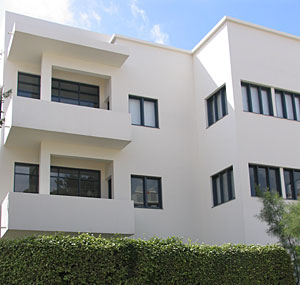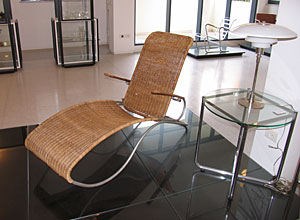

Photos © Esther Hecht
Tel Aviv’s new Bauhaus Museum is located in the White City, a collection of 1930s-era International Style buildings designated a UNESCO World Heritage site (top). The museum’s first show features furniture and other objects designed by Mies van der Rohe, Marcel Breuer, and others (above).
The 1,300-square-foot museum is located, appropriately, in an International Style building at 21 Bialik Street, owned by philanthropist and art collector Ron Lauder. The block-long street in the heart of Tel Aviv is lined with International Style and eclectic-style houses that were once the residences of writers, artists, and intellectuals. Much of the White City was built during Tel Aviv’s housing boom of the 1930s, when Bauhaus-trained Jewish architects who had fled Nazi Europe transplanted Modernist design concepts to the sandy shores of the Mediterranean. Interest in Tel Aviv’s Bauhaus legacy has grown tremendously during the past 20 years and received a boost from the United Nations Educational, Scientific, and Cultural Organization declaration.
The worldwide impact of the Bauhaus school cannot be overestimated, says museum founder and curator Daniella Luxembourg. “We see the world differently as a result of the Bauhaus design, typography, graphics and color theory,” she observes. Bauhaus influenced Israeli design, too, through the country’s premier arts school, Bezalel, founded in 1906. After closing in 1929, the school reopened in 1935 with many Bauhaus-trained teachers from Germany, emphasizing the study of typography and graphic and practical arts.
But few such items exist in Israel, partly because the inhabitants of the International Style buildings brought little with them when they fled Nazi Europe—and, Luxembourg says, because they considered Bauhaus furniture, with its tubular metal frames, too avant garde. Moreover, until the 1950s, the country lacked industrial facilities required for producing Bauhaus furnishings. Items in the museum’s first show are on loan from private collectors outside Israel.
The new museum’s home started life as a single-story residence in the 1920s; it was enlarged, a decade later, by architect Shlomo Gepstein. By the 1990s, it was dilapidated and largely abandoned, except for the ground floor, which housed a municipal dental clinic. Luxembourg, a high-profile art dealer, convinced the city to sell its part of the property in 1996 on condition that the exterior be preserved and the ground floor be used for a cultural endeavor. The building was renovated in 1996 by Luxembourg’s then husband, interior designer Boubi Luxembourg, and more recently by architect Tal Eyal.


Post a comment to this article
Report Abusive Comment